My Chicken Katsudon (Chicken Cutlet Rice Bowl) is a comforting lunch enjoyed by all ages in Japan. In this easy recipe, I use chicken tenders to make the crispy breaded katsu (cutlets), then quickly simmer them with eggs in a savory and sweet sauce. Served over a bowl of hot Japanese rice, it‘s a satisfying and delicious meal that your family will love.
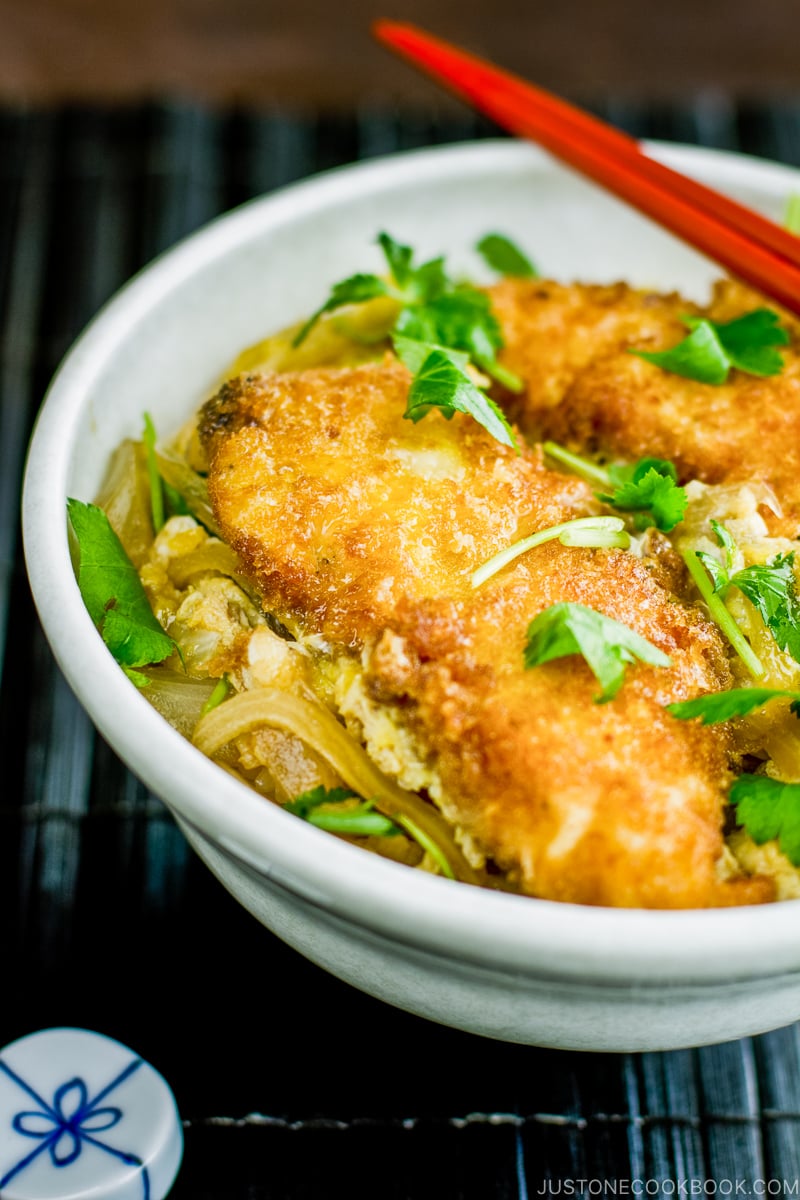
Today’s recipe Chicken Katsudon (チキンカツ丼) might “look” time-consuming but it’s actually not. It’s perfect for a busy day. I usually serve this dish with a bowl of miso soup and a small salad. Because it is served in a donburi (rice bowl) style, katsudon makes a balanced meal that is fulfilling.
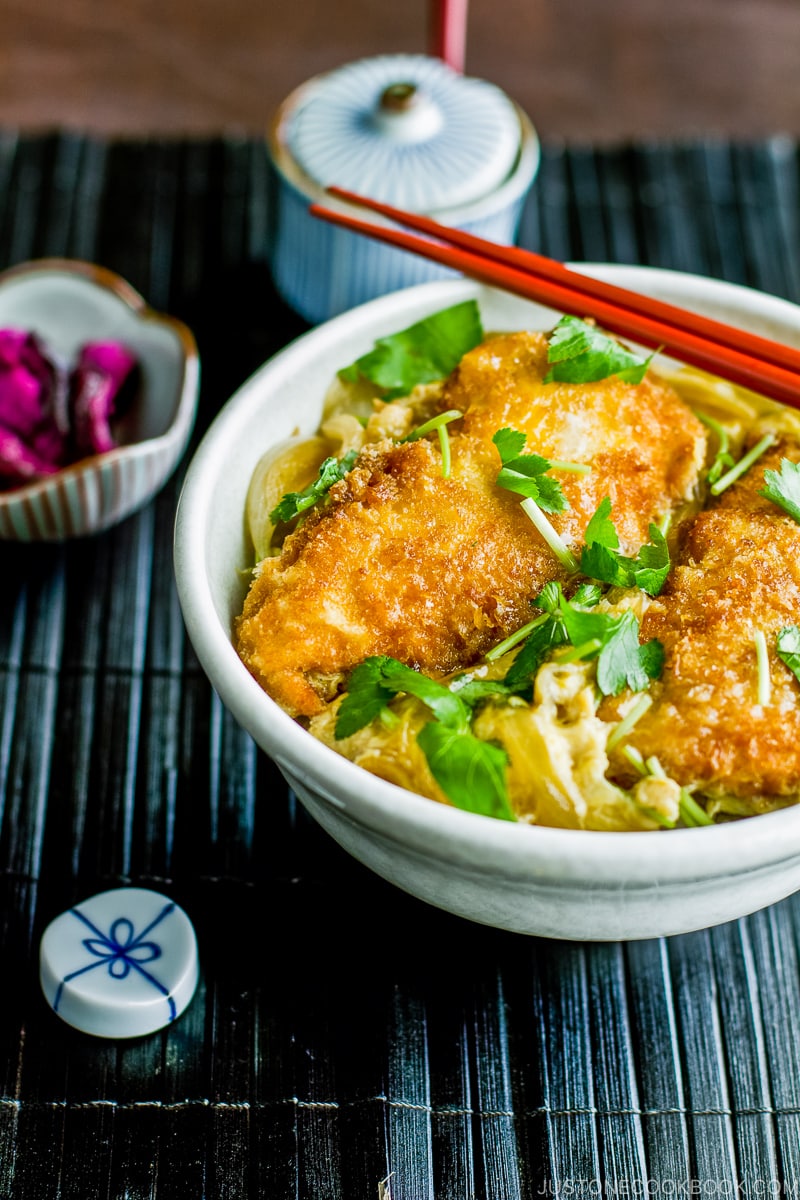
A more typical Katsudon is served with Tonkatsu (deep-fried pork cutlet). Chicken Katsudon is also a favorite, especially with the children. It’s a popular lunch dish in Japan and you can find it on the menu at every corner of shops, cafeterias, and restaurants.
My mom always makes Chicken Katsu with chicken tenders so that’s how I make it, but you can use chicken breasts or thighs. If you use chicken breasts, make sure to cut each piece thin so it will cook faster (Here’s the basic cutting technique to cut breasts thin).
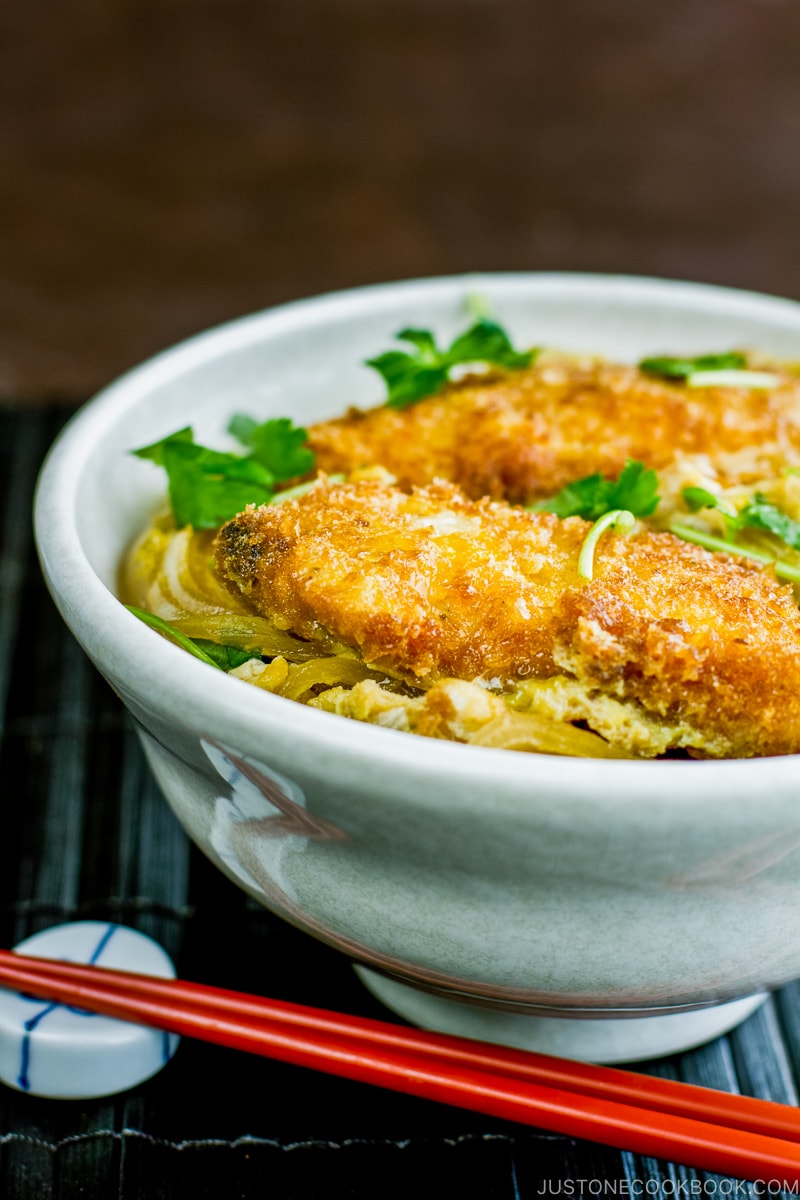
Shallow Fry instead of Deep Fry the Chicken Katsu
When it comes to home cooking, I know most of you try to avoid deep frying as much as possible. For this recipe, I apply the shallow frying technique instead of deep-frying to prepare the chicken katsu. It uses less oil and creates less mess on the kitchen counter. The chicken will brown beautifully with a crispy char on the surface and tender inside.
Alternatively, you can prepare the chicken using the oven with my Baked Chicken Katsu (揚げないチキンカツ) recipe.
To enjoy Chicken Katsudon, serve the golden fried chicken cutlet with savory-sweet onions cooked in dashi and eggs over hot steamed rice in a bowl. Top it off with mitsuba (Japanese wild parsley), and you will have a satisfying meal for the family.
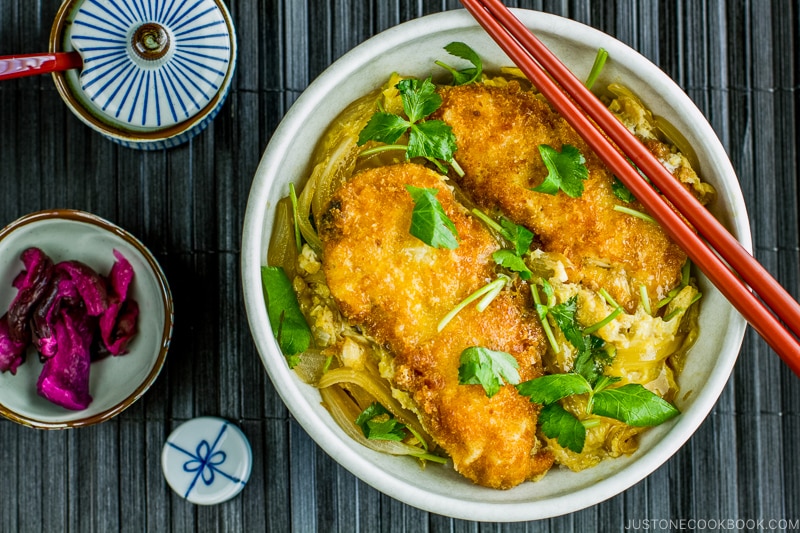
Wish to learn more about Japanese cooking? Sign up for our free newsletter to receive cooking tips & recipe updates! And stay in touch with me on Facebook, Pinterest, YouTube, and Instagram.

Chicken Katsudon
Ingredients
For the Chicken Katsu
- ¼ cup all-purpose flour (plain flour)
- 1 large egg (50 g each w/o shell) (beaten)
- 1 cup panko (Japanese breadcrumbs)
- 7 oz chicken tenders (4 tenders)
- Diamond Crystal kosher salt
- freshly ground black pepper
- 3 cups neutral oil (for frying)
For the Seasonings
- ⅔ cup dashi (Japanese soup stock) (use standard Awase Dashi, dashi packet or powder, or Vegan Dashi)
- 1½ Tbsp sake
- 1½ Tbsp mirin
- 1½ Tbsp soy sauce
- 1½ tsp sugar
For the Katsudon
- ½ onion (4 oz, 113 g; thinly sliced)
- 2 large eggs (50 g each w/o shell) (“cut“ the egg whites 5–6 times into smaller clumps so the yolks and whites are marbled; do not whisk or beat)
- 2 servings cooked Japanese short-grain rice (typically 1⅔ cups (250 g) per donburi serving)
- 4 sprigs mitsuba (Japanese parsley) (chopped; or substitute green onion)
- ichimi togarashi (Japanese chili pepper) (for a spicy kick)
Instructions
- Before You Start: Gather all the ingredients. For the steamed rice, please note that 1½ cups (300 g, 2 rice cooker cups) of uncooked Japanese short-grain rice yield 4⅓ cups (660 g) of cooked rice, enough for 2 donburi servings (3⅓ cups, 500 g). See how to cook short-grain rice with a rice cooker, pot over the stove, Instant Pot, or donabe.

To Make the Chicken Katsu
- Place ¼ cup all-purpose flour (plain flour), 1 large egg (50 g each w/o shell) beaten, and 1 cup panko (Japanese breadcrumbs) in individual bowls or plates. Next, season 7 oz chicken tenders with Diamond Crystal kosher salt and freshly ground black pepper. To bread the chicken, dust each piece with the flour and shake off any excess. Then, dip it into the beaten egg to coat completely. Finally, coat the chicken with the panko, pressing the panko into the cutlet so that it adheres well. Remove any excess. Set the breaded cutlets on a plate.

- Heat 3 cups neutral oil in a frying pan. Shallow-fry the panko-coated chicken at 340ºF (170ºC) until golden brown. Remove the chicken and place it on a wire rack or plate lined with paper towels to drain the extra oil.

To Make the Katsudon
- In another (or a clean) frying pan, add thin slices of ½ onion and all the ingredients for the seasonings—⅔ cup dashi (Japanese soup stock), 1½ Tbsp sake, 1½ Tbsp mirin, 1½ Tbsp soy sauce, and 1½ tsp sugar. Cover and bring it to a boil over medium heat. Once boiling, lower the heat to medium low and cook the onion, covered, until wilted.

- Place the chicken katsu on top of the onion slices and turn the heat up to medium. While you‘re waiting for it to heat up, prepare the eggs by lightly “cutting“ the egg whites with chopsticks 5–6 times into smaller clumps so the yolks and whites are marbled (do not whisk or beat). Once the cooking liquid is simmering, evenly distribute 2 large eggs (50 g each w/o shell) over the chicken katsu and onion in a circular pattern, avoiding the edges of the pan where the egg can easily overcook. Cover to cook until the eggs are set to your liking, roughly 30 seconds. Tip: For more tips and tricks for "cutting" and cooking the eggs, see my Oyakodon recipe.

- Top with the chopped 4 sprigs mitsuba (Japanese parsley) and turn off the heat. Divide 2 servings cooked Japanese short-grain rice into individual bowls. Gently transfer the simmered katsu and eggs on top of the steamed rice. Sprinkle the top with ichimi togarashi (Japanese chili pepper) for a spicy kick. Enjoy!

To Store
- You can keep the leftovers in an airtight container and store in the refrigerator for up to 3 days or in the freezer for a month.
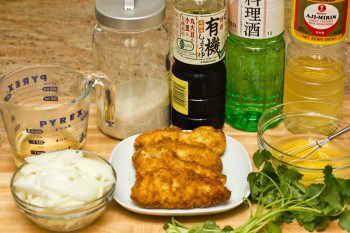



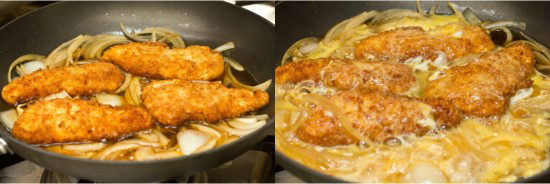



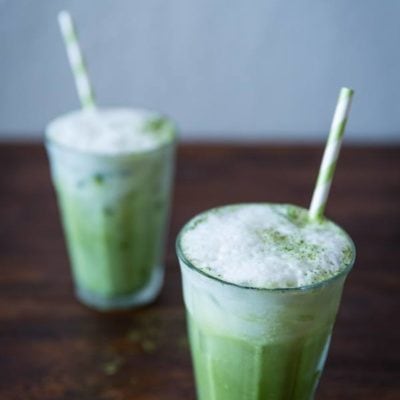

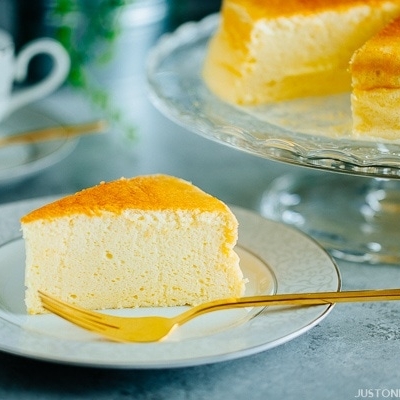


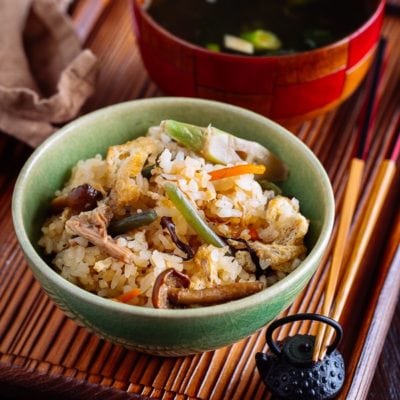
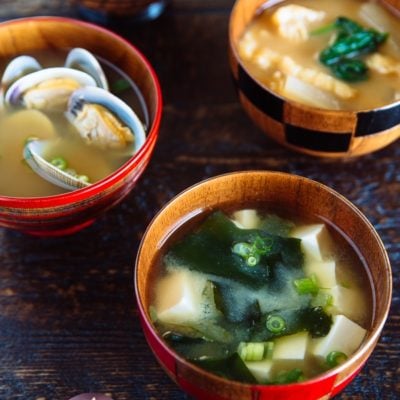

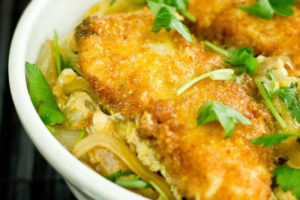
Absolutely LOVE LOVE LOVE this recipe! It’s a winner in our house. Thank you!
Hi Jan! Thank you so much for trying this recipe! I’m happy to hear you enjoyed this recipe! 🙂
My Aunt Ayako in Kyushu used to make this for my Father every time we visited. This recipe is great! I did make it slightly sweeter with a bit of honey to meet my Father’s taste.
Hi James! I’m so happy to hear you liked the recipe and you could replicate the recipe that suits your father’s taste! Thank you so much for your kind feedback. 🙂
This is so delicious. I’ve made it for my family twice already. And will continue to make it into infinity. Thank you so much for posting this recipe, Nami!
Hi Victoria! I’m so happy to hear you and your family enjoyed this dish! Thank you for trying this recipe and for your kind feedback. 🙂 xo
Hi, Nami
I love all your cooking of Nihon washoku especially katsu and donburi. Just ask if I can use your photos on those Washoku dishes for my presentation at my beginner Japanese language class by end of this month. I will use my own wording or phrases to describe the dishes.
Thanks for sharing your great recipe and your knowledge.
Regard, Lawrence
Hi Lawrence! Thank you for your kind words! Yes, that’s fine with me. If you need high res images, let me know. 🙂 Good luck with your presentation!
Hello Ms. Nami this is Cherise Guillory I tried making this dish it was a challenge but totally worth it tasted great but I have question for you if I make this dish earlier can I eat it later or should it be eat right then and now?
Hi Cherise! Thank you so much for trying this recipe! You can eat it later. Now, if you are planning to eat later, I will start from Step 5 when you’re ready to eat so it’s freshly made. But if you simply cannot finish what you made, then yes you can save it later and reheat in the microwave or in a frying pan. Hope I answered your question. 🙂
[…] to Gyudon and Katsudon, Oyakodun is not only a long-time favorite at restaurants but also a favorite to make at Japanese […]
[…] This recipe and image adapted from: http://www.justonecookbook.com […]
Waaaay too salty! I did as the receipt said and used 2/3 cup of dashi and I ended up with an inedible salty mess! There’s gotta be a typo or something. Dail back on the dashi A LOT and it would be incredibly delicious.
Hi Crystal! I’m sorry yours didn’t come out well, but I want to know how it became so salty.
How did you make dashi? Did you make homemade or use dashi powder (which includes MSG and salt)? Because the salt content is ONLY 1½ Tbsp soy sauce and the rest is a non-salty ingredient for the liquid (⅔ cup dashi + 1½ Tbsp sake + 1½ Tbsp mirin). Or maybe at Step 2, you sprinkle salt too much? Also, if you use table salt, you need to use 1/2 of kosher salt (which I use). Hope that helps.
I hadn’t realized that dashi was hyperlinked to a dashi stock recipe. So, misinterpreted 2/3 cup of dashi as 2/3 cup of dashi powder. Whoops! I plan on making it again tonight to see how it turns out.
Hi Crystal! Oh my! 2/3 cup of dashi powder!!!!!!!!! I can totally see now how salty it must have been! I do not use dashi powder in my cooking, except for a few occasion. Dashi means Japanese stock. We can make it from scratch, dashi packet (like a tea bag) or dashi powder. The fragrance and taste disappear quickly with dashi powder, so I usually don’t use it (plus we can avoid MSG and other stuff). I hope you will enjoy the recipe this time. 🙂 Thank you for trying my recipe and for your feedback.
Everything worked out perfectly this time around. It is absolutely delishois. I will definitely be making this again!
Hi Crystal! Aww thank you for trying this recipe again! I’m glad it came out well and you enjoyed it. Thanks so much for taking your time to comment here. I really appreciate it! 🙂
Hi Nami
Do you know if I Can use chicken or vegetable stock instead of dashi?
Hi Martyna! You “can” use chicken or vegetable stock, but there is no “authentic” Japanese taste without dashi in it. Dashi is the key for the flavor that makes this dish taste “Japanese”. Without it, just panko breaded chicken, rice, egg… lack of Japanese flavor. Hope that makes sense.
I tried this awesome recipe yesterday! Sooooo yummy! <3
Hi Franzi! Thank you so much for trying this recipe and I’m so happy to hear you enjoyed it! ox
Made a vegetarian version of this using a Chik’n patty in the oven. It was absolutely delicious! Once the patty and rice are cooked, the rest of it comes together really quickly. I’d highly recommend it for busy weeknights.
Hi Tomboy! Yay! I’m so happy to hear you enjoyed this recipe with Chik’n patty. 🙂 Thank you so much for your kind feedback!
thank you for this excellent recipe. I was trying to copy what I got at a japanese restaurant in Vancouver, BC and this fit the bill! It is now going to be one of my regulars! 😉
Hi Annie! I’m so happy to hear you liked this recipe! I love Japanese restaurants in Vancouver! Thank you for your kind feedback. xo 🙂
I’ve been eating Chicken Katsudon for 16 years. Never did I think I could make it myself but tried this tonight and my family and I loved this!!!! Took me 1 1/2 hours to make the first time but I will surely make this again and again.
Thank you!
Noel
Hi Noel! Happy to hear you enjoyed this recipe! Thank you for your kind feedback! 🙂
Hi! I was wondering, if I can’t get mitsuba, is there any other herb I could substitute it with when making this dish?
Hi Momo! Mitsuba has this unique aroma and flavor that is not similar to other herbs so I usually recommend to omit. I can’t think of any other suitable herbs that you can use of. I’d say scallion/green onion is best fit for this recipe. 🙂
Hi Nami! Thank you so much for the advice! Unfortunately, we weren’t able to go grocery shopping again today so we couldn’t get mitsuba or scallion/green onion. My mom and I still went ahead though and made the Chicken Katsu Don for dinner, and it turned out great! Thanks for posting such a nice recipe. 😀
Hi Momo! I’m so happy to hear you and your mom enjoyed this recipe! Thank you for your kind feedback! 🙂
Hi, I can’t find Sake so I bought Rice Wine Vinegar. Is it ok to replace Sake? Thanks!
Hi Teo! No, it doesn’t work. Sake is rice wine, just like Chinese rice wine. Rice wine vinegar is vinegar so it can’t be replaced. You can use dry sherry or Chinese rice wine if you can’t find sake. 🙂
I never leave comments on recipes, but i must say, this was absolutely delicious!!! My whole family was skeptical of the egg, but they all loved it!
Hi Edward! Aww!. Thank you so much for your kind feedback on this recipe. I’m so happy to hear you and your family enjoyed this dish! 🙂